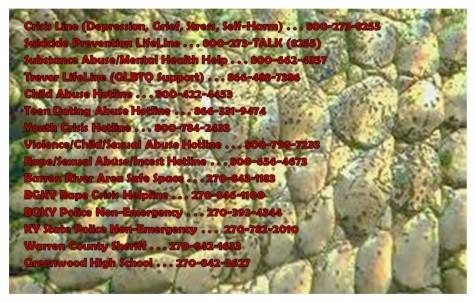Student IDs intended to improve safety on and off campus
If you are a student at GHS, you may be confused because you have been given a mysterious laminated card with your picture on it. These cards are student IDs, and they are part of a new program intended to improve the safety of GHS students.
The concept for the IDs was developed by English teacher Mrs. Collins and Student Resource Officer Pete Rich. They were inspired to take action when a suspicious vehicle was parked in the school lot for a long period of time. Upon investigating the vehicle, they determined the name of its owner, and that they were affiliated with the school, but there was one big problem: they couldn’t tell if the owner was a teacher, staff member, student, or administrator. Eventually, they discovered the full identity of the owner, but not after a long search that could have delayed them enough that a safety hazard could have slipped by them.
Mrs. Collins and Officer Rich discussed making a list of all people associated with GHS, separating students, teachers, and staff members, complete with pictures to help identify them. To further improve safety, they envisioned all GHS personnel carrying ID badges with their picture, so that they could prove their affiliation with the school if asked. Thus, the student IDs were created.
The IDs are composed of two main sections:
On the front of the card, all the way to the left, is a picture of the card holder, with their name and ID number below. On the right is the current year and the school’s name.
On the back is a list of important phone numbers for students to call if they need help. In addition to the numbers for the school and the Warren County Sheriff’s department, there are helplines for non-emergencies, such as the Barren River Area Safe Space and the Teen Dating Abuse Hotline.
Mrs. Collins felt that many students face dangers that aren’t immediately life-threatening, and so they don’t know where to go for help. “You can’t just call 9-1-1 for these things,” she says. She hopes that this list of phone numbers will give them someone to turn to.
Officer Rich and Mrs. Collins also had other visions for the ID cards outside of just improving school safety.
On test day for the ACT, students must present some kind of identification other than their admission ticket, ideally a driver’s license, but most underclassmen don’t even have a learner’s permit by that point. In addition, to get a learner’s permit, you also need a picture I.D., but that can be problematic. “A learner’s permit is usually the first form of official identification a person gets,” Mrs. Collins says. “If you need a learner’s permit to get a learner’s permit, that starts a cycle and you can’t get it.” Especially for students who are not long-time or permanent residents of Kentucky or the U.S., a school-issued I.D. could be the only official identification they have.
On this same strain of thought, a student I.D. can help law enforcement to handle incidents involving GHS students swiftly and without putting too much burden on their families. If a student is rendered unconscious or unable to remember who they are in an accident, officials can identify them using their school I.D. and can get them help without confusing them or putting more stress on their already distraught loved ones by asking them to identify the student.
Most students don’t anticipate having to use their I.D.s for these purposes, however, and feel that they’re rather pointless. But Mrs. Collins and Officer Rich have big ambitions to integrate the cards into students’ daily lives.
“We’re thinking about adding magnetic strips,” Mrs. Collins says. “That way students can just swipe their cards to buy lunch or check out library books.”
The pair hope to speed up any check-out or sign-up activities at school by making the I.D. cards a universal ticket.
Currently, to purchase school lunch, students have to enter their PIN and have the transaction processed by a cafeteria worker, but if students could swipe their I.D. card, the lunch lines would speed up dramatically and students would have more time to eat.
Students enrolled in 6th period Dual Credit classes have the opportunity to check out of school early on set days, but since there are so many people trying to check out on one computer in the front foyer, such a long line builds up that students can end up waiting for up to 30 or 45 minutes. If students could simply swipe their card as they walk out the door, the line would move significantly faster and cause less blockage in the front hallway.
Mrs. Collins and Officer Rich have some more creative and out-of-the-box ideas for the cards as well, including:
- Stickers on the front of the card that can be purchased and used as all-season sports passes
- Stickers to denote membership in certain clubs and act as admission passes to meetings
- Swiping or signing card as bathroom pass
- Checking out library books or tech equipment
The team is more than happy to hear any suggestions for more cool or convenient uses for the I.D.s. If you have an idea, just see Mrs. Collins in the front hallway of the school.
Though these cards may be just a simple form of identification now, in the future, with more planning and support, they may revolutionize ordinary school functions at GHS.






